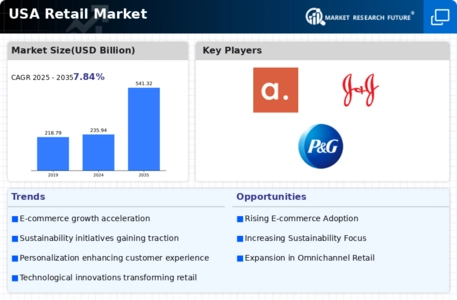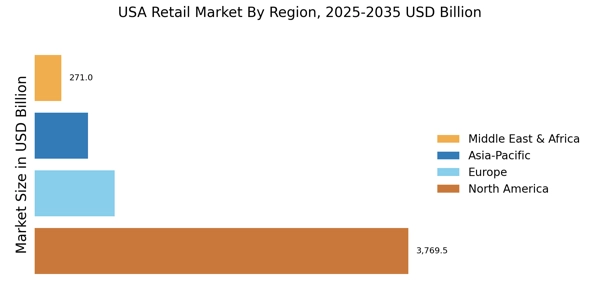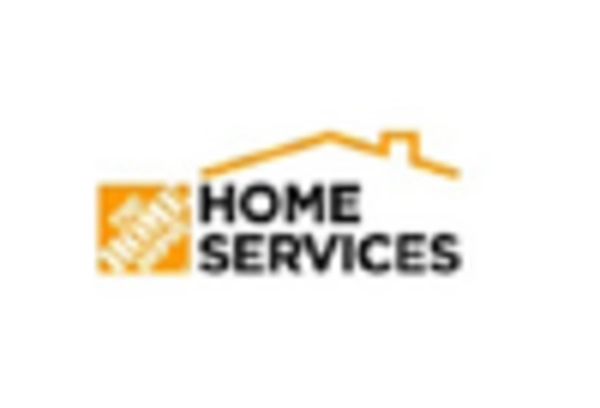E-commerce Growth
The USA Retail Market is experiencing a robust shift towards e-commerce, driven by changing consumer preferences and technological advancements. As of 2025, e-commerce sales account for approximately 20% of total retail sales in the United States, reflecting a significant increase from previous years. This trend is likely to continue as consumers increasingly favor the convenience of online shopping. Retailers are investing heavily in their digital platforms, enhancing user experience, and optimizing logistics to meet the growing demand. The rise of mobile commerce also plays a crucial role, with consumers utilizing smartphones for shopping, further propelling e-commerce growth. This transformation is reshaping the competitive landscape of the USA Retail Market, compelling traditional retailers to adapt or risk obsolescence.
Supply Chain Resilience
The USA Retail Market is increasingly focusing on supply chain resilience, particularly in response to recent disruptions. Retailers are recognizing the importance of robust supply chains to ensure product availability and customer satisfaction. As of 2025, approximately 75% of retailers are investing in supply chain technologies to enhance visibility and responsiveness. This includes adopting advanced analytics and automation to predict demand fluctuations and manage inventory more effectively. Additionally, diversifying suppliers and sourcing locations is becoming a common strategy to mitigate risks associated with global supply chains. By strengthening their supply chains, retailers in the USA Retail Market are better positioned to respond to market changes and consumer demands, ultimately enhancing their competitive edge.
Changing Consumer Behavior
The USA Retail Market is currently influenced by evolving consumer behavior, particularly among younger generations. Millennials and Generation Z are prioritizing experiences over material goods, leading to a shift in purchasing patterns. As of 2025, surveys indicate that nearly 70% of consumers prefer brands that align with their values, such as sustainability and social responsibility. This shift is prompting retailers to adapt their offerings and marketing strategies to resonate with these values. Furthermore, the demand for transparency in sourcing and production processes is rising, compelling retailers to provide more information about their products. This change in consumer behavior is reshaping the competitive dynamics within the USA Retail Market, as brands that fail to adapt may struggle to retain customer loyalty.
Sustainability Initiatives
Sustainability initiatives are becoming a central focus within the USA Retail Market, as consumers increasingly demand environmentally responsible practices. As of 2025, nearly 65% of consumers are willing to pay more for sustainable products, indicating a significant market shift. Retailers are responding by implementing eco-friendly practices, such as reducing packaging waste, sourcing sustainable materials, and promoting energy-efficient operations. This trend is not only beneficial for the environment but also enhances brand loyalty among consumers who prioritize sustainability. Furthermore, regulatory pressures are encouraging retailers to adopt greener practices, as governments implement stricter environmental regulations. Consequently, sustainability is likely to remain a key driver in the USA Retail Market, influencing product development and marketing strategies.
Technological Advancements
Technological innovations are fundamentally altering the USA Retail Market, enabling retailers to enhance operational efficiency and customer engagement. The integration of artificial intelligence, machine learning, and data analytics allows retailers to personalize shopping experiences, optimize inventory management, and streamline supply chains. As of 2025, it is estimated that over 60% of retailers are utilizing advanced technologies to improve customer interactions and drive sales. Additionally, the adoption of augmented reality and virtual reality is providing immersive shopping experiences, attracting tech-savvy consumers. These advancements not only improve customer satisfaction but also create new revenue streams for retailers. Consequently, the USA Retail Market is likely to witness a continuous evolution as technology becomes increasingly embedded in retail operations.


















Leave a Comment